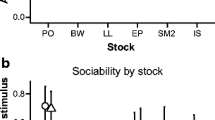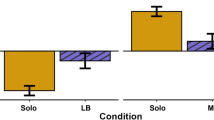Abstract
Recently, there has been increasing interest in behavioral syndrome research across a range of taxa. Behavioral syndromes are suites of correlated behaviors that are expressed either within a given behavioral context (e.g., mating) or between different contexts (e.g., foraging and mating). Syndrome research holds profound implications for animal behavior as it promotes a holistic view in which seemingly autonomous behaviors may not evolve independently, but as a “suite” or “package.” We tested whether laboratory-reared male and female European house crickets, Acheta domesticus, exhibited behavioral syndromes by quantifying individual differences in activity, exploration, mate attraction, aggressiveness, and antipredator behavior. To our knowledge, our study is the first to consider such a breadth of behavioral traits in one organism using the syndrome framework. We found positive correlations across mating, exploratory, and antipredatory contexts, but not aggression and general activity. These behavioral differences were not correlated with body size or condition, although age explained some of the variation in motivation to mate. We suggest that these across-context correlations represent a boldness syndrome as individual risk-taking and exploration was central to across-context mating and antipredation correlations in both sexes.


Similar content being viewed by others
References
Alexander RD (1961) Aggressiveness, territoriality, and sexual behavior in field crickets (Orthoptera: Gryllidae). Behaviour 17:130–223
Bateman PW, Fleming PA (2005) Direct and indirect costs of limb autotomy in field crickets, Gryllus bimaculatus. Anim Behav 69:151–159
Bateman PW, Fleming PA (2006a) Increased susceptibility to predation for autotomized house crickets (Acheta domestica). Ethology 112:670–677
Bateman PW, Fleming PA (2006b) Sex, intimidation and severed limbs: the effect of simulated predator attack and limb autotomy on calling and emergence behaviour in the field cricket Gryllus bimaculatus. Behav Ecol Sociobiol 59:674–681
Bell AM (2005) Behavioural differences between individuals and two populations of stickleback (Gasterosteus aculeatus). J Evol Biol 18:464–473
Bell AM (2007) Future directions in behavioural syndromes research. Proc R Soc Lond B Biol Sci 274:755–761
Benjamini Y, Drai D, Elmer N, Golani I (2001) Controlling the false discovery rate in behavior genetics research. Behav Brain Res 125:279–284
Bertram SM, Orozco SX, Bellani R (2004) Temporal shifts in conspicuousness: mate attraction displays of the Texas field cricket, Gryllus texensis. Ethology 110:963–975
Brown WD, Smith AT, Moskalik B, Gabriel J (2006) Aggressive contests in house crickets: size, motivation and the information content of aggressive songs. Anim Behav 72:225–233
Brown WD, Chimenti AJ, Siebert JR (2007a) The payoff of fighting in house crickets: motivational asymmetry increases male aggression and mating success. Ethology 113:457–465
Brown C, Jones F, Braithwaite VA (2007b) Correlation between boldness and body mass in natural populations of the poeciliid Brachyrhaphis episcopi. J Fish Biol 71:1590–1601
Coleman K, Wilson DS (1998) Shyness and boldness in pumpkinseed sunfish: individual differences are context-specific. Anim Behav 56:927–936
Crankshaw OS (1979) Female choice in relation to calling and courtship songs in Acheta domesticus. Anim Behav 27:1274–1275
Dingemanse NJ, Réale D (2005) Natural selection and animal personality. Behaviour 142:1159–1184
Dingemanse NJ, Wright J, Kazem AJN, Thomas DK, Hickling R, Dawnay N (2007) Behavioural syndromes differ predictably between 12 populations of three-spined stickleback. J Anim Ecol 76:1128–1138
Dochtermann NA, Jenkins SH (2007) Behavioural syndromes in Merriam’s kangaroo rats (Dipodomys merriami): a test of competing hypotheses. Proc R Soc Lond B Biol Sci 274:2343–2349
Drent PJ, van Oers K, van Noordwijk AJ (2003) Realized heritability of personalities in the great tit (Parus major). Proc R Soc Lond B Biol Sci 270:45–51
Dugatkin LA, Alfieri MS (2003) Boldness, behavioral inhibition and learning. Ethol Ecol Evol 15:43–49
Fleming PA, Bateman PW (2007) Just drop it and run: the effect of limb autotomy on running distance and locomotion energetics of field crickets (Gryllus bimaculatus). J Exp Biol 210:1446–1454
Fraser DF, Gilliam JF, Daley MJ, Le AN, Skalski GT (2001) Explaining leptokurtic movement distributions: intrapopulation variation in boldness and exploration. Am Nat 158:124–135
Godin J-GJ, Davis SA (1995) Who dares, benefits: predator approach behavior in the guppy (Poecilia reticulata) deters predator pursuit. Proc R Soc Lond B Biol Sci 259:193–200
Godin J-GJ, Dugatkin LA (1996) Female mating preference for bold males in the guppy, Poecilia reticulata. Proc Natl Acad Sci U S A 93:10262–10267
Gray DA (1997) Female house crickets, Acheta domesticus, prefer the chirps of large males. Anim Behav 54:1553–1562
Gray DA (1999) Intrinsic factors affecting female choice in house crickets: time cost, female age, nutritional condition, body size, and size-relative reproductive investment. J Insect Behav 12:691–700
Hedrick AV (2000) Crickets with extravagant mating songs compensate for predation risk with extra caution. Proc R Soc Lond B Biol Sci 267:671–675
Hedrick AV, Kortet R (2006) Hiding behaviour in two cricket populations that differ in predation pressure. Anim Behav 72:1111–1118
Hofmann HA, Schildberger K (2001) Assessment of strength and willingness to fight during aggressive encounters in crickets. Anim Behav 62:337–348
Huntingford FA (1976) Relationship between anti-predator behavior and aggression among conspecifics in 3-spined stickleback, Gasterosteus aculeatus. Anim Behav 24:245–260
Huntingford FA (2004) Implications of domestication and rearing conditions for the behaviour of cultivated fishes. J Fish Biol 65:122–142
Johnson JC, Sih A (2005) Precopulatory sexual cannibalism in fishing spiders (Dolomedes triton): a role for behavioral syndromes. Behav Ecol Sociobiol 58:390–396
Johnson JC, Sih A (2007) Fear, food, sex and parental care: a syndrome of boldness in the fishing spider, Dolomedes triton. Anim Behav 74:1131–1138
Killian KA, Allen JR (2008) Mating resets male cricket aggression. J Insect Behav 21:535–548
Kortet R, Hedrick A (2007) A behavioural syndrome in the field cricket Gryllus integer: intrasexual aggression is correlated with activity in a novel environment. Biol J Linn Soc 91:475–482
Martin JGA, Réale D (2008) Temperament, risk assessment and habituation to novelty in eastern chipmunks, Tamias striatus. Anim Behav 75:309–318
McDougall PT, Réale D, Sol D, Reader SM (2006) Wildlife conservation and animal temperament: causes and consequences of evolutionary change for captive, reintroduced, and wild populations. Anim Conserv 9:39–48
Moretz JA, Martins EP, Robison BD (2007) Behavioral syndromes and the evolution of correlated behavior in zebrafish. Behav Ecol 18:556–562
Nakagawa S (2004) A farewell to Bonferroni: the problems of low statistical power and publication bias. Behav Ecol 15:1044–1045
Narum SR (2006) Beyond Bonferroni: less conservative analyses for conservation genetics. Conserv Genet 7:783–787
Nelson CM, Nolen TG (1997) Courtship song, male agonistic encounters, and female mate choice in the house cricket, Acheta domesticus (Orthoptera: Gryllidae). J Insect Behav 10:557–570
Price T, Langen T (1992) Evolution of correlated characters. Trends Ecol Evol 7:307–310
Quinn JL, Cresswell W (2005) Personality, anti-predation behaviour and behavioural plasticity in the chaffinch Fringilla coelebs. Behaviour 142:1377–1402
Réale D, Festa-Bianchet M (2003) Predator-induced natural selection on temperament in bighorn ewes. Anim Behav 65:463–470
Réale D, Reader SM, Sol D, McDougall PT, Dingemanse NJ (2007) Integrating animal temperament within ecology and evolution. Biol Rev 82:291–318
Rehage JS, Sih A (2004) Dispersal behavior, boldness, and the link to invasiveness: a comparison of four Gambusia species. Biol Invasions 6:379–391
Riechert SE, Hedrick AV (1993) A test for correlations among fitness-linked behavioral traits in the spider Agelenopsis aperta (Araneae, Agelenidae). Anim Behav 46:669–675
Sih A, Bell AM (2007) Insights from behavioural syndromes for the evolutionary genetics of personality. Eur J Pers 21:626–628
Sih A, Watters JV (2005) The mix matters: behavioural types and group dynamics in water striders. Behaviour 142:1417–1431
Sih A, Bell A, Johnson JC (2004a) Behavioral syndromes: an ecological and evolutionary overview. Trends Ecol Evol 19:372–378
Sih A, Bell AM, Johnson JC, Ziemba RE (2004b) Behavioral syndromes: an integrative overview. Q Rev Biol 79:241–277
Sinn DL, Gosling SD, Moltschaniwskyj NA (2008) Development of shy/bold behaviour in squid: context-specific phenotypes associated with developmental plasticity. Anim Behav 75:433–442
Smith BR, Blumstein DT (2008) Fitness consequences of personality: a meta-analysis. Behav Ecol 19:448–455
Stapley J, Keogh JS (2005) Behavioral syndromes influence mating systems: floater pairs of a lizard have heavier offspring. Behav Ecol 16:514–520
Stout JF, McGhee R (1988) Attractiveness of the male Acheta domestica calling song to females. 2. The relative importance of syllable period, intensity, and chirp rate. J Comp Physiol A Sens Neural Behav Physiol 164:277–287
Stout JF, Dehaan CH, McGhee RW (1983) Attractiveness of the male Acheta domesticus calling song to females. 1. Dependence on each of the calling song features. J Comp Physiol 153:509–521
Svartberg K, Forkman B (2002) Personality traits in the domestic dog (Canis familiaris). Appl Anim Behav Sci 79:133–155
Ward AJW, Thomas P, Hart PJB, Krause J (2004) Correlates of boldness in three-spined sticklebacks (Gasterosteus aculeatus). Behav Ecol Sociobiol 55:561–568
Webster MM, Ward AJW, Hart PJB (2007) Boldness is influenced by social context in threespine sticklebacks (Gasterosteus aculeatus). Behaviour 144:351–371
Wilson ADM, Godin J-GJ (2009) Boldness and behavioral syndromes in the bluegill sunfish, Lepomis macrochirus. Behav Ecol 20:231–237
Wilson ADM, McLaughlin RL (2007) Behavioural syndromes in brook charr, Salvelinus fontinalis: prey-search in the field corresponds with space use in novel laboratory situations. Anim Behav 74:689–698
Wilson ADM, Stevens ED (2005) Consistency in context-specific measures of shyness and boldness in rainbow trout, Oncorhynchus mykiss. Ethology 111:849–862
Wilson DS, Clark AB, Coleman K, Dearstyne T (1994) Shyness and boldness in humans and other animals. Trends Ecol Evol 9:442–446
Wright D, Nakamichi R, Krause J, Butlin RK (2006) QTL analysis of behavioral and morphological differentiation between wild and laboratory zebrafish (Danio rerio). Behav Genet 36:271–284
Acknowledgements
We thank Hans Hofmann and two anonymous reviewers for their extensive and helpful comments on an earlier version of this manuscript. We also thank Dhara Vyas for her assistance with a subset of the behavioral trials, Raphael Jeanson for designing and writing the Excel macro used in most behavioral trials, Luke Johnson for designing the EAR system used in mate attraction quantification, Jeff Dawson for his technical assistance, and Amanda Goth for her assistance with cricket husbandry. We gratefully acknowledge the Natural Science and Engineering Research Council of Canada (NSERC) for an Individual Discovery Grant awarded to S.M.B. and postgraduate doctoral scholarship to A.D.M.W. We thank Carleton University for start-up funds awarded to S.M.B. used to purchase equipment, materials, and supplies and partially support undergraduate researchers engaged in this research project. We thank NSERC for the Undergraduate Student Research Awards which partially supported E.W. and R.B. An NSERC Individual Discovery Grant awarded to Jean-Guy Godin (Carleton University) partially supported A.D.M.W.
Author information
Authors and Affiliations
Corresponding author
Additional information
Communicated by D. Gwynne
Rights and permissions
About this article
Cite this article
Wilson, A.D.M., Whattam, E.M., Bennett, R. et al. Behavioral correlations across activity, mating, exploration, aggression, and antipredator contexts in the European house cricket, Acheta domesticus . Behav Ecol Sociobiol 64, 703–715 (2010). https://doi.org/10.1007/s00265-009-0888-1
Received:
Revised:
Accepted:
Published:
Issue Date:
DOI: https://doi.org/10.1007/s00265-009-0888-1




